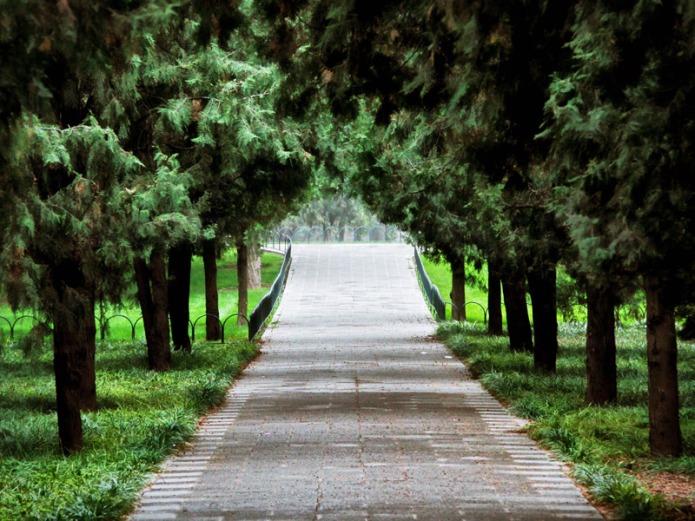 Melodic strains of zither, fiddle, and flute drift through the cypress grove as I jog down the path. It is too early in the morning and too chilly in Beijing (北京), China to be outdoors, yet an apparent concert is happening in the grounds of the Temple of Heaven (天坛). I follow the refrain to discover a band of middle-aged women practicing tai chi (太極) in a clearing. A boombox ekes out the music strains to which they perform. The ladies make well-coordinated, balletic movements in slow motion, raising their arms and hands to the sky, lifting their legs. A few yards away two monks train at wing chun (詠春). I watch the men’s varied stances and choreographed actions until I am distracted by a flying shuttlecock landing in front of me.
Melodic strains of zither, fiddle, and flute drift through the cypress grove as I jog down the path. It is too early in the morning and too chilly in Beijing (北京), China to be outdoors, yet an apparent concert is happening in the grounds of the Temple of Heaven (天坛). I follow the refrain to discover a band of middle-aged women practicing tai chi (太極) in a clearing. A boombox ekes out the music strains to which they perform. The ladies make well-coordinated, balletic movements in slow motion, raising their arms and hands to the sky, lifting their legs. A few yards away two monks train at wing chun (詠春). I watch the men’s varied stances and choreographed actions until I am distracted by a flying shuttlecock landing in front of me.
“We are social animals, relying on neighbors, friends, and philopatric strangers to forge our civic duties, support our economic needs, and sustain our desire to be understood.”
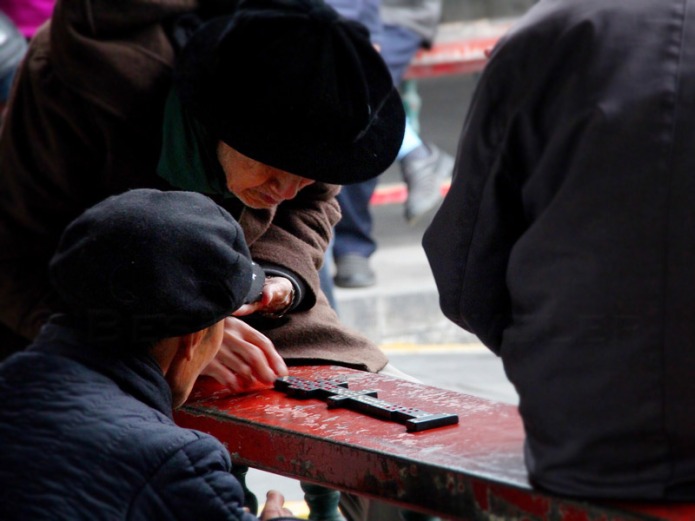 A boy in a knit cap runs by to retrieve it and I tag along to where his father waits. They continue their badminton game as I attend their volleys. On a spur of the moment the elder hands his racket to me. I trade shots with the kid for a while before lobbing the feathered cone too far. The son crows with delight and chases after it. I thank the man, return his racket, then continue my run through the park. Along the way I come across a collection of elderly men and women sitting upon railings. I assume they are waiting in line to enter part of the fifteenth century complex. As I get closer, however, I notice they each have their heads bent in concentration. Some of them mutter, others slap their thighs in frustration. I pause and approach the crowd. They are clustered in groups of five or seven and between each circle is a mahjong (麻將) board. Tiles click in fierce precision, the only consistent sound other than birds twittering in the bushes.
A boy in a knit cap runs by to retrieve it and I tag along to where his father waits. They continue their badminton game as I attend their volleys. On a spur of the moment the elder hands his racket to me. I trade shots with the kid for a while before lobbing the feathered cone too far. The son crows with delight and chases after it. I thank the man, return his racket, then continue my run through the park. Along the way I come across a collection of elderly men and women sitting upon railings. I assume they are waiting in line to enter part of the fifteenth century complex. As I get closer, however, I notice they each have their heads bent in concentration. Some of them mutter, others slap their thighs in frustration. I pause and approach the crowd. They are clustered in groups of five or seven and between each circle is a mahjong (麻將) board. Tiles click in fierce precision, the only consistent sound other than birds twittering in the bushes.
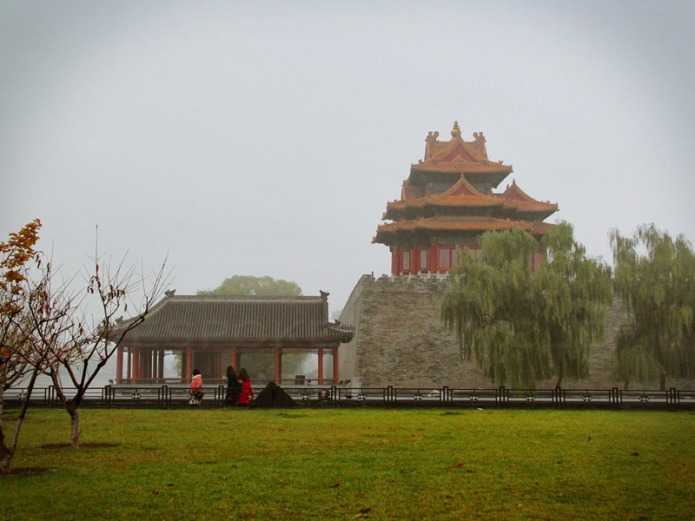 To escape the smog-ridden streets, I have been coming to the green acres around Temple of Heaven for fresh air. Every morning on my circuit I pass by grandparents playing with their charges, school girls rehearsing dance routines, calisthenics clubs, and the mahjong congregation. It’s not a peculiarity of the shrine. Arriving at the square in front of the Gǔlóu (鼓楼) or drum tower, I cross paths with a youthful gang of jianzi (毽子) players. Lost in the warren of Xīchéng’s (西城區) back alleys I ask directions from a troop of families enjoying their communal courtyard. Though much of Beijing is being rebuilt into car-friendly avenues and high-rises, locals are managing to carve out spaces where they gather for exercise, gossip, and fellowship.
To escape the smog-ridden streets, I have been coming to the green acres around Temple of Heaven for fresh air. Every morning on my circuit I pass by grandparents playing with their charges, school girls rehearsing dance routines, calisthenics clubs, and the mahjong congregation. It’s not a peculiarity of the shrine. Arriving at the square in front of the Gǔlóu (鼓楼) or drum tower, I cross paths with a youthful gang of jianzi (毽子) players. Lost in the warren of Xīchéng’s (西城區) back alleys I ask directions from a troop of families enjoying their communal courtyard. Though much of Beijing is being rebuilt into car-friendly avenues and high-rises, locals are managing to carve out spaces where they gather for exercise, gossip, and fellowship.
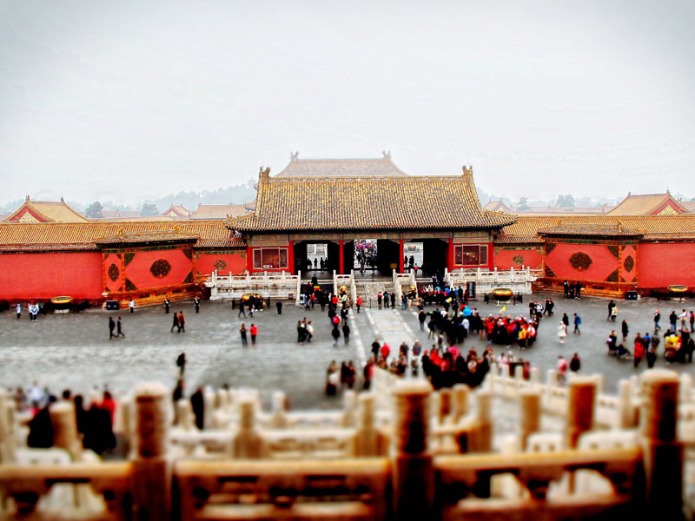 We are social animals, relying on neighbors, friends, and philopatric strangers to forge our civic duties, support our economic needs, and sustain our desire to be understood. Metropolises are ideally suited to provide such connections because they force close contact interactions. Most of the time, however, I do not consider municipalities as harbingers of sociability. I think of them as rabbit burrows where residents scurry, shoulders hunched, furtive, avoiding glances, chagrinned by any inconvenience. They are incarcerators, devoid of free space, entrapping all who enter into a maze of unknowable dead ends. For many, they represent dark recesses of villainy enlivened by minuscule pockets of light for the affluent.
We are social animals, relying on neighbors, friends, and philopatric strangers to forge our civic duties, support our economic needs, and sustain our desire to be understood. Metropolises are ideally suited to provide such connections because they force close contact interactions. Most of the time, however, I do not consider municipalities as harbingers of sociability. I think of them as rabbit burrows where residents scurry, shoulders hunched, furtive, avoiding glances, chagrinned by any inconvenience. They are incarcerators, devoid of free space, entrapping all who enter into a maze of unknowable dead ends. For many, they represent dark recesses of villainy enlivened by minuscule pockets of light for the affluent.
“A socially connected district can be a community whose members fully possess the nuances of their territory.”
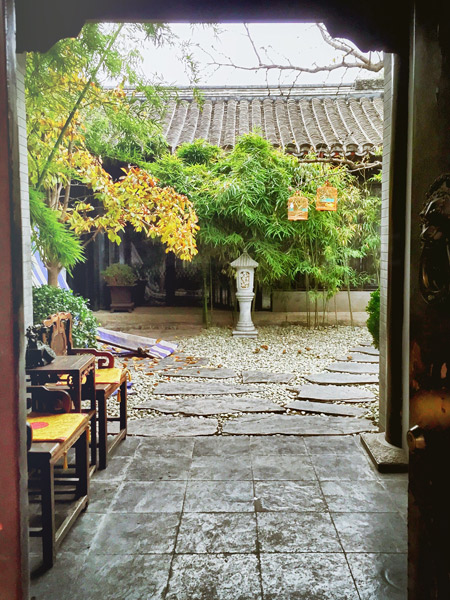 Yet I have witnessed cities ruled by its citizens. In Barcelona, the Gràcia passages reverberate with the passion of laughter and discussion as young and old live their lives upon outdoor café tables. Boutiques cater to lingerers, plazas become meeting points for students, and park benches hold cooing sweethearts. From Cape Town’s Table Mountain to its frothy shore, residents embrace their environs through braais and impromptu footie matches. The riverfront hosts block parties. The downtown thoroughfares spill over with fanfare from competing pubs and restaurants. Now, in Beijing, I see my uninhabited surroundings transformed from scenery to active participants in urban existence. It is in the details that these cities becomes personable: the shop keeper sweeping her bit of sidewalk, the two brothers walking unsupervised to school, the game of chess waiting to be played under the gingko tree, the geriatrics limbering up for morning aerobics at the market.
Yet I have witnessed cities ruled by its citizens. In Barcelona, the Gràcia passages reverberate with the passion of laughter and discussion as young and old live their lives upon outdoor café tables. Boutiques cater to lingerers, plazas become meeting points for students, and park benches hold cooing sweethearts. From Cape Town’s Table Mountain to its frothy shore, residents embrace their environs through braais and impromptu footie matches. The riverfront hosts block parties. The downtown thoroughfares spill over with fanfare from competing pubs and restaurants. Now, in Beijing, I see my uninhabited surroundings transformed from scenery to active participants in urban existence. It is in the details that these cities becomes personable: the shop keeper sweeping her bit of sidewalk, the two brothers walking unsupervised to school, the game of chess waiting to be played under the gingko tree, the geriatrics limbering up for morning aerobics at the market.
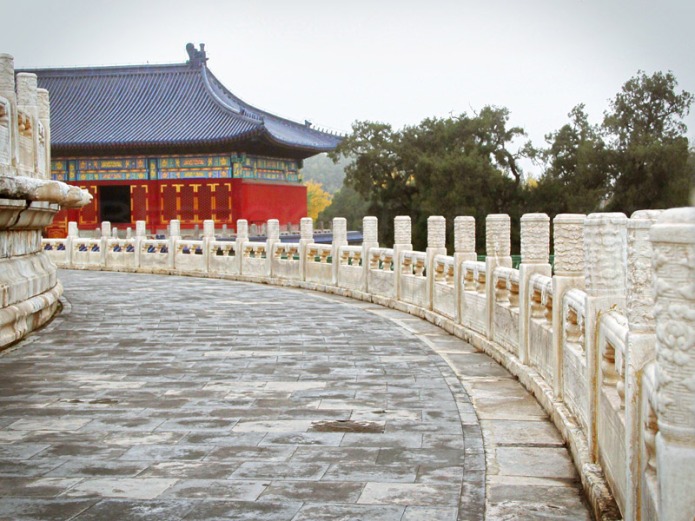 So many boroughs seem afraid of their public spaces. Gathering crowds fill them with dread thoughts of revolutions and insurrections. Gardens are kept to minimum slivers of drab lawn, playgrounds are nonexistent, piazzas devoid of seats. Governments are convinced that what people desire is more indoor malls and less footpaths. Administrations hunger for efficiency and productivity as hallmarks of the ideal megapolis. A place, however, belongs to those who use it. When an urban domain is ceded to corporations and highway systems it dies. People en masse complicate a geographical region: they create snafus, cause disorder, generate waste. Acting together they also invigorate the location with their ideas, their skills, and their enthusiasms. I am beginning to comprehend the importance of utilizing the civic scope of a metropolis —reshape how you live there and you reconstruct the area. A socially connected district can be a community whose members fully possess the nuances of their territory.
So many boroughs seem afraid of their public spaces. Gathering crowds fill them with dread thoughts of revolutions and insurrections. Gardens are kept to minimum slivers of drab lawn, playgrounds are nonexistent, piazzas devoid of seats. Governments are convinced that what people desire is more indoor malls and less footpaths. Administrations hunger for efficiency and productivity as hallmarks of the ideal megapolis. A place, however, belongs to those who use it. When an urban domain is ceded to corporations and highway systems it dies. People en masse complicate a geographical region: they create snafus, cause disorder, generate waste. Acting together they also invigorate the location with their ideas, their skills, and their enthusiasms. I am beginning to comprehend the importance of utilizing the civic scope of a metropolis —reshape how you live there and you reconstruct the area. A socially connected district can be a community whose members fully possess the nuances of their territory.
 I may have come to the festivities too late. For years, I was shuffling my way through grubby urban tunnels, head down, eyes averted, wishing for nothing more than the competent machinery to spit me rapidly to the next terminus. I never took leisurely walks through accessible courtyards, never loitered over boulevard buskers, never assembled at al fresco parades. Now, as shared spots vanish replaced by commercial blocks and private realms, I am losing my chance to interface with these destinations. I am unable to get to know them. Happily Beijing is giving me an opportunity. On my morning lap through the Temple of Heaven I sneak into the back of one of the tai chi sessions. I attempt the graceful gestures; though I am both newcomer and uncoordinated, the eclectic group accepts me as one of their own. I sample teas in Shichahai (什刹海) while chefs show me how they clean their daily fish. I stop to listen to an impromptu choir in Jingshan Park (景山). After accomplishing their initial number, the singers donate their only chair to me so I may better enjoy their work. Slowly, Beijingren (北京人) teach me to rediscover their home through engagement with their public spaces.
I may have come to the festivities too late. For years, I was shuffling my way through grubby urban tunnels, head down, eyes averted, wishing for nothing more than the competent machinery to spit me rapidly to the next terminus. I never took leisurely walks through accessible courtyards, never loitered over boulevard buskers, never assembled at al fresco parades. Now, as shared spots vanish replaced by commercial blocks and private realms, I am losing my chance to interface with these destinations. I am unable to get to know them. Happily Beijing is giving me an opportunity. On my morning lap through the Temple of Heaven I sneak into the back of one of the tai chi sessions. I attempt the graceful gestures; though I am both newcomer and uncoordinated, the eclectic group accepts me as one of their own. I sample teas in Shichahai (什刹海) while chefs show me how they clean their daily fish. I stop to listen to an impromptu choir in Jingshan Park (景山). After accomplishing their initial number, the singers donate their only chair to me so I may better enjoy their work. Slowly, Beijingren (北京人) teach me to rediscover their home through engagement with their public spaces.

TRAVEL NOTE:
Sìhéyuàn (四合院) or courtyard houses once formed the backbone of Beijing. Designed east-to-west for fēng shuǐ (風水) these walled properties created the well-known hútòng (衚衕), narrow alleys spidering the metropolis. Many of these old neighborhoods have been razed to make way for modern apartment towers, brand name superstores, and vehicular broadways. A few survive around Lake Hòu Hǎi (后海), south of Qiánmén (前門), and Dōngchéng (東城). Unlike historic royal palaces, the hútòng remains the social and communal center for Beijing citizens.
Do you have a favorite urban public space? Is there a city where public spaces are central to its personality that we did not mention? Let us know in the comments section below.
Discover more from Bespoke Traveler
Subscribe to get the latest posts sent to your email.



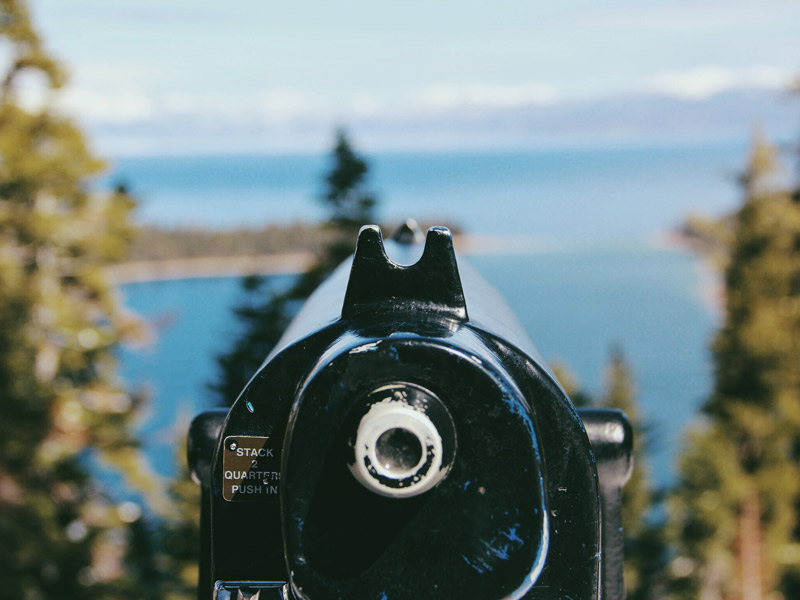

Thank you for directing me here! Very interesting post. The use of our public spaces is so important for any community. In Vancouver thank goodness we have many public spaces, trees are revered, and people fill the parks year round. I think perhaps it is unique to China that there are so many organized classes, or groups, in the parks.
Your photographs are exquisite.
Alison
Ever since my China trip, I’ve been thinking about the availability of public spaces and how they’re used in different countries as well as the proliferation of private-public spaces in the Western Hemisphere. I agree with you – public space is integral to holding together any community and lack of it in urban spaces is not a good sign. Thanks so much for visiting this post Alison! I appreciate your thoughts on this topic.
Amazing! Beijing is on my check list! 😊
Hello from Paris (France)
I’m so happy to see your photography of Beijing because I remember my travel in 1993 ; it was a wonderful travel and a special experience for a young girl.
So ; now I would like returning there but my money possibility is not good for, so I dream
Hello to you in Paris. I am delighted that my Beijing photos brought back sweet memories of your China travels. The beauty of stories and photographs is that they can transport us (whatever our finances) to worlds far beyond our own, allowing us to adventure through time and space to anywhere we desire. Thank you for your visit, your kind words. May your travel dreams come true soon. Until then never stop dreaming.
Wow, really wonderful photos of Beijing, I’ve always been curious about this place!
Thank you, glad you enjoyed my photos. Let me know if you have any questions about Beijing!
I have always wanted to visit China! I have a strong interest in their history and culture, and your well-written post now has me feverishly planning my dream vacation to Beijing!
Thank you, I hope you get the chance to visit the country and see some of the amazing ancient architecture there.
A wonderful post that made me nostalgic for Beijing. I lived there in the run-up to the Olympics and had a real love-hate relationship with the city. So many contradictions, such a clash between tradition and modernity. I’d love to go back for a visit one day.
😆 Yes, I so understand your feeling about Beijing. They mirror my own while I was exploring China. Aside from the intense pollution, much of it was a cultural clash for me which I tried hard to overcome. Many of the Asian countries I have been in have this strange dichotomy of modern and traditional, which at times can be overwhelming and at other times surreally beautiful. Thank you so much for sharing your thoughts with me about this city!
Beautifully written as always!
Thank you so much. Very happy you enjoyed it. 🙂
A beautiful post! Took me back to our very short 4 day trip to Beijing. You capture the contrasts of Beijing very well. I think, wherever we’ve traveled, we’ve seen development slowly take over. The old world is slowly losing out. And yet, I think China has so many green spots, to head out and explore nature. We were taken aback by the number of parks in Shanghai!
Thank you for your kind words. It was lovely to see so many green spaces still alive in various parts of China. It always fills me with sadness to see them being slowly taken over by development in any country.
These photos are incredible: I love the colours and the contrasts. Everything looks so atmospheric with the fog, which is great for photos, not so great for life…